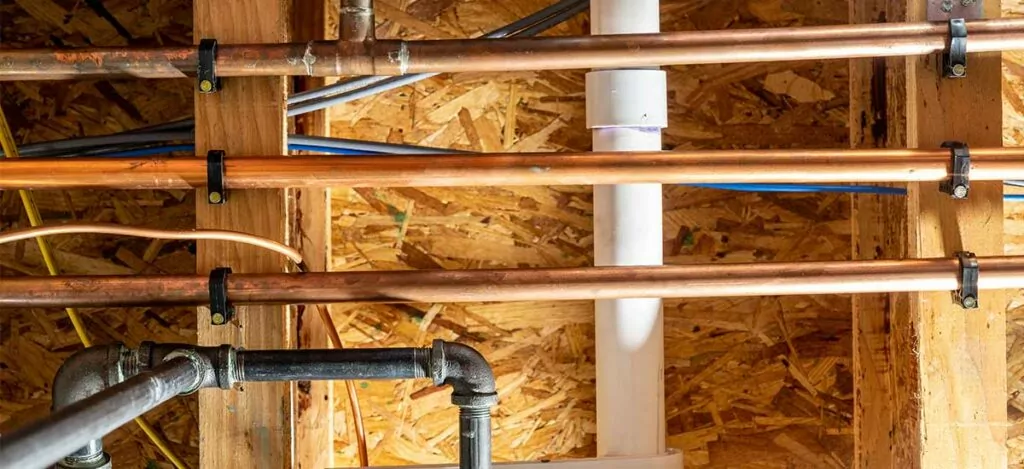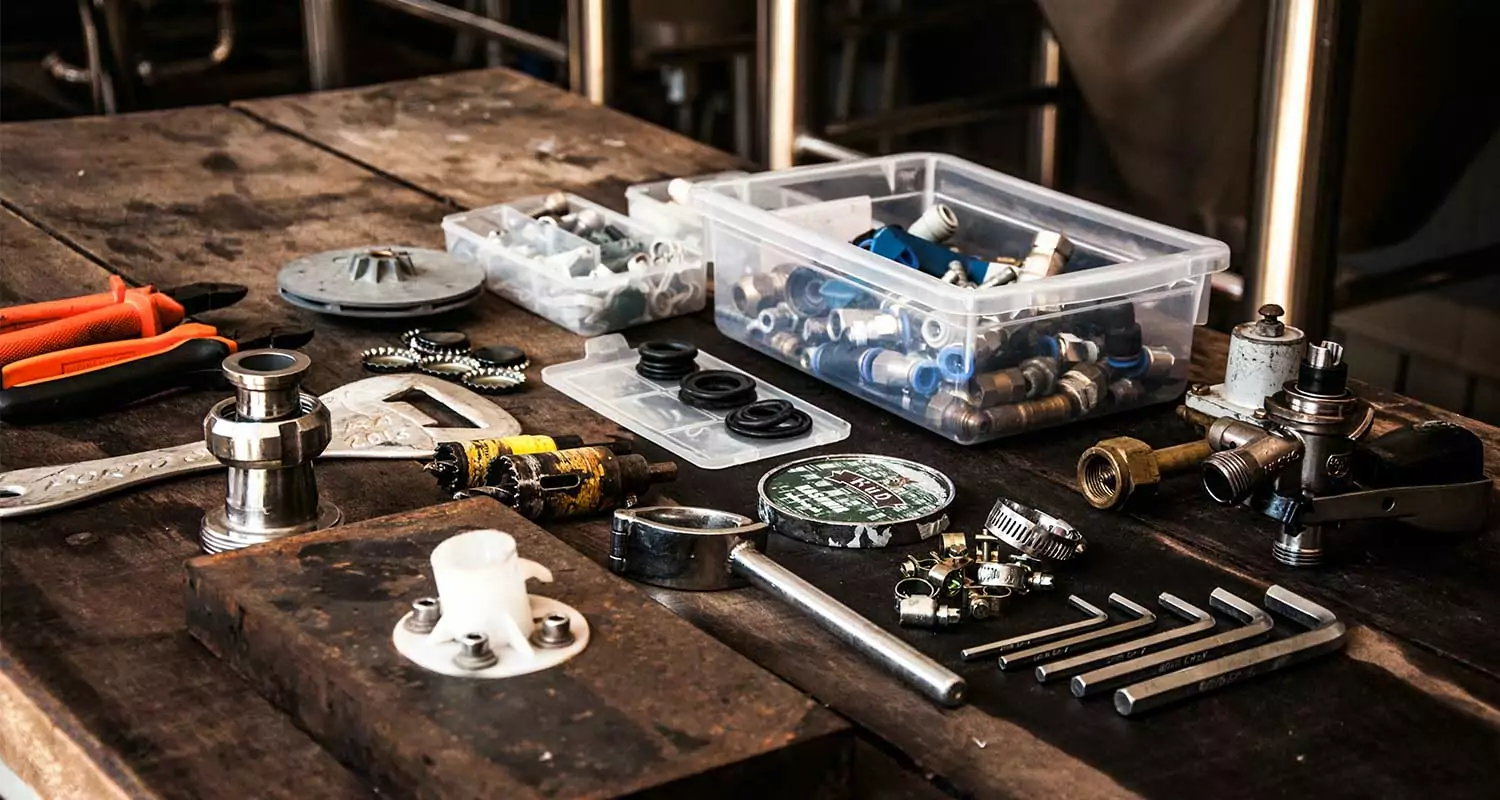Residential plumbing is an essential aspect of every home. It encompasses the plumbing system and services specific to residential properties, providing the necessary infrastructure for water supply and drainage systems. From plumbing fixtures to household systems, residential plumbing plays a crucial role in ensuring the functionality and convenience of our homes.
Key Takeaways:
- Residential plumbing involves the plumbing systems and services specific to home environments.
- It includes plumbing fixtures, drainage systems, and water supply systems in residential properties.
- Residential plumbing work includes tasks such as installing and repairing plumbing fixtures, ensuring proper water pressure, and fixing leaks.
- Commercial plumbing differs significantly from residential plumbing and involves complex plumbing systems in commercial buildings.
- While there are differences between residential and commercial plumbing, both play vital roles in providing essential plumbing services.
Key Components of a Residential Plumbing System

A plumbing system comprises several essential components that work together to ensure the proper functioning of the household’s water supply and drainage system.
Water Supply System
The water supply system is responsible for bringing clean and safe water into the house for various purposes, such as drinking, cooking, and sanitation. It consists of the following key elements:
- Water Meter: A device that measures the amount of water consumed by the household.
- Water Main: The main pipe that delivers water from the municipal supply to the entire plumbing system of the house.
- Shut-off Valve: A valve that allows users to turn off the water supply to the entire house in case of emergencies or plumbing repairs.
- Pressure Regulator: A device that maintains steady water pressure within a safe range, preventing damages to the plumbing system and fixtures.
Water Distribution System
The water distribution system ensures that water is distributed throughout the house, providing access to water at various fixtures. Its components include:
- Pipes: A network of pipes that transport water from the main supply to different areas of the house.
- Faucets and Fixtures: These include kitchen and bathroom faucets, showerheads, and other fixtures that allow users to access water.
- Water Heater: A device that heats water for domestic use, providing hot water for showers, washing dishes, or laundry.
Drainage System
The drainage system is responsible for the proper disposal of wastewater, keeping the house clean and hygienic. Key components of the drainage system include:
- Drain Pipes: These pipes carry wastewater from sinks, showers, toilets, and other fixtures to the main sewer or septic system.
- Vent Pipes: These pipes allow air to enter the drainage system, preventing the accumulation of foul odors and maintaining the proper flow of wastewater.
- Traps: Traps are curved sections of pipe designed to retain water, forming a barrier that prevents harmful sewer gases from entering the house.
These key components work together harmoniously to ensure the smooth operation of a residential plumbing system, providing clean water supply and efficient wastewater disposal.
Differences Between Residential and Commercial Plumbing

In the world of plumbing, there are significant distinctions between residential and commercial plumbing. While both involve the installation, repair, and maintenance of plumbing systems, the complexity of the tasks and the scale of the projects differ greatly.
Residential Plumbing
Residential plumbing primarily caters to the plumbing needs of individual homes and household systems. It revolves around providing essential plumbing services to residential properties, ensuring the uninterrupted supply of clean water and efficient disposal of wastewater.
- Focuses on single-family homes and small residential buildings.
- Deals with standard plumbing fixtures, such as sinks, toilets, showers, and bathtubs.
- Includes water supply systems, drainage systems, and water heaters specific to residential properties.
- Repairs and maintenance typically involve fixing leaks, clogged drains, and other common plumbing issues.
Projects often require the expertise of skilled residential plumbers who specialize in serving homeowners by ensuring the seamless operation of plumbing systems within their properties.
Commercial Plumbing
On the other hand, commercial plumbing caters to the plumbing needs of commercial buildings, such as office buildings, restaurants, and large-scale establishments. Commercial plumbing projects involve more complex systems and require skilled commercial plumbers with specialized knowledge and expertise.
- Deals with plumbing systems in commercial buildings, which are often larger and more intricate than residential systems.
- Involves temporary plumbing facilities, multiple floors, and extensive plumbing networks.
- Requires handling complex installation, repair, and maintenance tasks to ensure the proper functioning of the plumbing system.
- Addresses plumbing problems specific to commercial buildings, such as sewer line issues.
- Handles commercial drainage systems and complex plumbing projects in existing buildings and large plants.
Commercial plumbers possess the necessary skills and expertise to navigate the complexities of commercial plumbing, ensuring that the plumbing systems in commercial buildings meet the unique demands of these environments.
“Commercial plumbing requires skilled plumbers who can handle the intricacies of complex plumbing systems in commercial buildings.”
The Differences at a Glance
| Residential Plumbing | Commercial Plumbing |
|---|---|
| Focuses on single-family homes and small residential buildings. | Deals with plumbing systems in large-scale commercial buildings. |
| Primarily handles standard plumbing fixtures and systems. | Involves complex plumbing fixtures and extensive plumbing networks. |
| Repairs and maintenance involve common plumbing issues. | Handles complex installation and repairs, addressing commercial plumbing problems. |
| Projects typically require skilled residential plumbers. | Requires skilled commercial plumbers with expertise in commercial plumbing. |
The differences between residential and commercial plumbing is important for ensuring that the right plumbing services are sought for each specific need. Whether it’s the plumbing systems in homes or the intricate networks in commercial buildings, having the right professionals address plumbing requirements is essential for the efficient functioning and longevity of the plumbing system.
Wrapping It Up
In conclusion, residential plumbing involves the plumbing systems and services specific to home environments. It deals with various aspects such as plumbing fixtures, drainage systems, and water supply systems in residential properties. The work of residential plumbing includes tasks like installing and repairing plumbing fixtures, ensuring proper water pressure, and fixing leaks.
On the other hand, commercial plumbing differs significantly from residential plumbing. It encompasses more complex plumbing systems found in commercial buildings and requires skilled commercial plumbers. Commercial plumbing projects often involve dealing with extensive plumbing systems, addressing commercial drainage systems, and handling the unique challenges of commercial buildings.
While there are significant differences between residential and commercial plumbing, both play vital roles in providing essential plumbing services to their respective environments. Residential plumbing services cater to individual homes and household systems, while commercial plumbing services are tailored for commercial buildings and establishments. Residential plumbing involves fixing common household plumbing problems, while commercial plumbing may require dealing with larger-scale plumbing issues.
Regardless of the differences, both residential and commercial plumbing contribute to the overall functionality and convenience of their respective properties. Properly functioning plumbing systems, whether residential or commercial, are essential for the comfort and health of occupants. Whether it’s ensuring clean water supply, efficient drainage, or promptly fixing any plumbing problems, residential and commercial plumbers play crucial roles in maintaining the plumbing infrastructure of homes and businesses alike.
What you should do next
If you’re navigating the complexities of residential plumbing in San Antonio, Chambliss is your go-to solution. Our services are tailored to address every aspect of your home’s plumbing needs.
We understand the intricacies of residential plumbing, from the installation and repair to ensuring proper water pressure and fixing leaks. We have years of experience, catering specifically to the unique requirements of San Antonio homes. This specialization not only guarantees a high level of service but also ensures that our solutions are perfectly aligned with the local plumbing challenges and standards.
Whether it’s routine maintenance, emergency repairs, or upgrades to your plumbing system, our team of skilled professionals is equipped to provide efficient, reliable, and timely service. By choosing Chambliss Plumbing Company, you’re choosing a partner dedicated to the health and efficiency of your home’s plumbing system.
FAQ
What Type of Plumbing is Best?
The best type of plumbing depends on specific needs and the building’s structure. Copper piping is highly durable and resistant to corrosion, making it a popular choice for long-term reliability. PEX piping, being flexible and easy to install, is increasingly favored in modern constructions for its cost-effectiveness and versatility.
What is the Most Common Plumbing Item to Fail in a Residential Home?
In homes, the most common plumbing failure often involves faucets and toilets. Dripping faucets and running toilets are frequent issues, usually due to worn-out washers or flappers. These are relatively easy to fix but can cause significant water wastage if left unattended.
What Type of Plumbing is No Longer Used?
Galvanized steel pipes are no longer used in modern plumbing. Previously common, these pipes are prone to corrosion and rust over time, leading to reduced water pressure and potential contamination. There are safer and more durable materials nowadays like copper and PEX, which are preferred.
What are 3 Things Plumbing Plans Include?
Plumbing plans typically include the layout of pipes, the location of fixtures like sinks and toilets, and the specifications for the water supply system. These plans ensure that plumbing is efficient, meets building codes, and integrates seamlessly with the building’s overall design.
